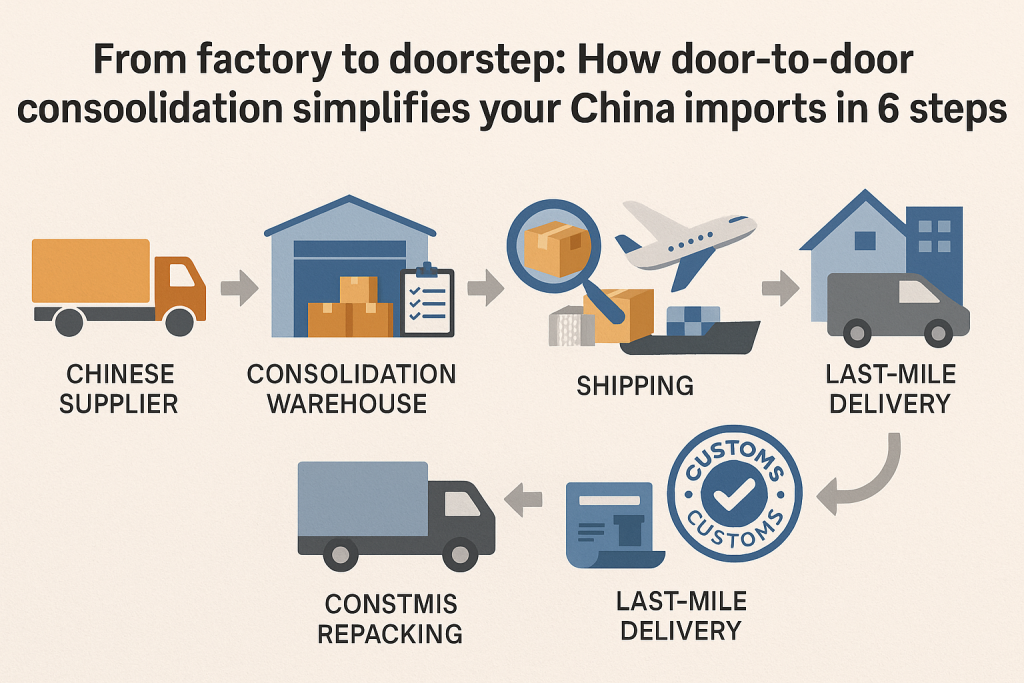Door-to-Door Consolidated Shipping from China to Europe – Save Up to 65%
1. Introduction: Why Door-to-Door Consolidation is a Game Changer
If you are a European or North American business—or even an individual importer—sourcing products from multiple suppliers in China, you may already be familiar with the headaches:
- Multiple invoices and packing lists.
- Repeated customs clearance charges.
- High per-shipment freight rates.
- Complicated tracking from different couriers.
- Delays in delivery.
Door-to-door consolidated shipping solves these problems by merging shipments from multiple suppliers into one streamlined delivery, from the factory floor in China to your home, warehouse, or business address in Europe or North America.
This guide explains exactly how the process works, how much you can save, and what to watch out for—based on real-world logistics practices.

2. What is Door-to-Door Consolidated Shipping?
Door-to-door consolidated shipping combines two powerful logistics strategies:
- Consolidation – Multiple supplier orders are sent to a central warehouse in China, inspected, repacked, and shipped together as one cargo.
- Door-to-Door Service – The logistics provider handles everything from pickup at the supplier’s location to final delivery at your address, including customs clearance and last-mile delivery.
Instead of paying for 5–10 separate shipments, you pay for one single shipment. This results in significant cost savings, faster clearance, and easier tracking.
3. How the Process Works (Step-by-Step)
Step 1: Supplier Coordination
- You purchase goods from multiple suppliers (e.g., in Shenzhen, Yiwu, Guangzhou).
- Provide your consolidation warehouse address to each supplier.
Step 2: Receiving & Inspection in China
- The consolidation warehouse receives each supplier’s goods.
- Items are inspected for quantity, quality, and damages.
- Inspection photos and reports are sent to you for approval.
Step 3: Repacking for Safety & Efficiency
- Fragile items are wrapped in anti-static bubble wrap or foam padding.
- All goods are packed into reinforced cartons or pallets to prevent transit damage.
- Pallets are labelled with a single HS code list for customs.
Step 4: Documentation Consolidation
- All supplier invoices, packing lists, and certificates of origin are merged into one master invoice and one packing list.
- Customs documents are prepared to meet EU or US import requirements.
Step 5: International Shipping
- The shipment travels by air, sea, or rail depending on urgency and budget.
- The entire cargo has a single tracking number.
Step 6: Customs Clearance
- Customs clearance is done once for the whole shipment.
- Duties and VAT are calculated on the combined shipment value.
Step 7: Last-Mile Delivery
- Once cleared, the shipment is handed to a domestic courier for delivery to your home or business.
4. Cost Benefits: How Much You Can Save
Example: 50kg electronics shipment to Paris from 5 suppliers
| Shipping Method | Cost (€) | Customs Fees (€) | Total (€) |
|---|---|---|---|
| Individual Air Shipments | 1,200 | 300 | 1,500 |
| Door-to-Door Air Consolidation | 720 | 180 | 900 |
| Door-to-Door Sea Consolidation | 420 | 180 | 600 |
Savings:
- Air consolidation: 40% cheaper
- Sea consolidation: up to 65% cheaper
5. Customs Clearance Advantages
When you ship individually, each package requires separate customs processing. This leads to:
- Multiple duty calculations (higher total duties).
- Multiple broker fees.
- Increased delay risk.
Consolidation means:
- One customs entry → one duty payment, one VAT calculation.
- Reduced inspection probability → fewer random checks.
- Lower clearance fees → one set of charges instead of many.
6. Risk Reduction & Safety Measures
Consolidation reduces risks in several ways:
- Better Packing – Warehouses use professional-grade materials to protect mixed goods.
- Less Handling – Fewer handovers mean fewer opportunities for damage.
- Single Tracking – Reduces the risk of lost packages.
- Priority Loading – Reputable consolidators have strong relationships with carriers to reduce the risk of “container rollovers” during peak season.
7. Air vs. Sea vs. Rail Consolidation
| Mode | Transit Time | Cost | Best For |
|---|---|---|---|
| Air | 4–10 days | High | Urgent, high-value goods |
| Sea | 25–40 days | Low | Bulk, non-urgent goods |
| Rail | 15–25 days | Medium | Mid-sized shipments to Europe |
8. Ideal Users & Industries
- E-commerce sellers importing from multiple Chinese suppliers.
- Small manufacturers needing regular parts shipments.
- Retailers sourcing seasonal collections from China.
- Individuals relocating or importing large personal orders.
9. Case Studies & Examples
Case Study 1: German Electronics Importer
- 7 suppliers, 300kg total.
- Used sea consolidation → saved €4,800 compared to separate shipments.
Case Study 2: UK Fashion Boutique
- Urgent summer collection from 4 factories.
- Used air consolidation → delivery in 7 days, saved 42% on freight.
10. Choosing a Reliable Consolidation Partner
Look for:
- Proven track record with your target market (EU/US).
- Transparent pricing and no hidden fees.
- Strong carrier relationships to avoid rollovers.
- In-house customs brokers.
- Real-time tracking system.
11. Common Mistakes to Avoid
- Not checking packing standards → high damage risk.
- Choosing price over reliability → possible delays.
- Failing to plan for customs → extra storage fees.
- Not consolidating documents → longer clearance time.
12. Conclusion & Call-to-Action
Door-to-door consolidated shipping from China to Europe or North America is not just about saving money—it’s about reducing stress, improving efficiency, and ensuring your goods arrive safely and on time.
If you want to cut your shipping costs by up to 65%, simplify customs clearance, and protect your cargo, it’s time to work with a trusted consolidation partner.
